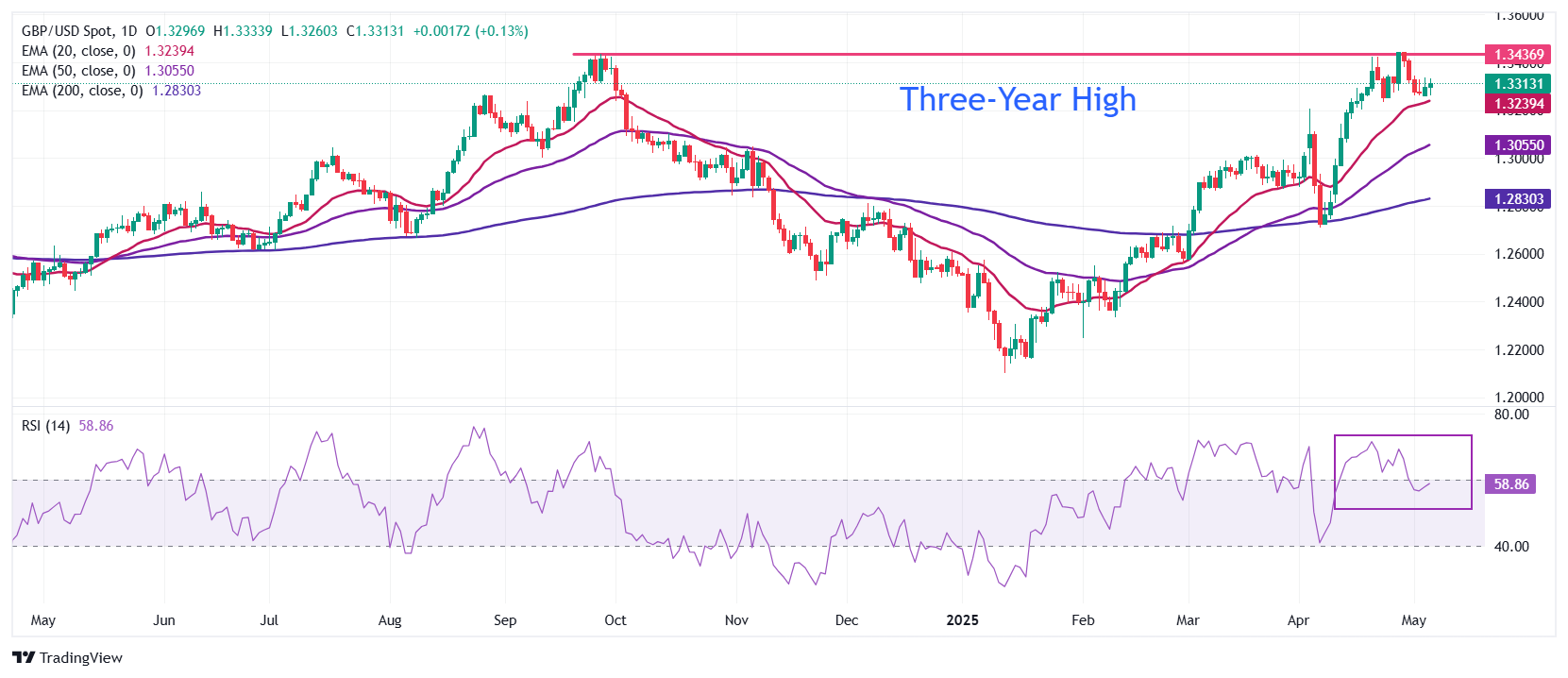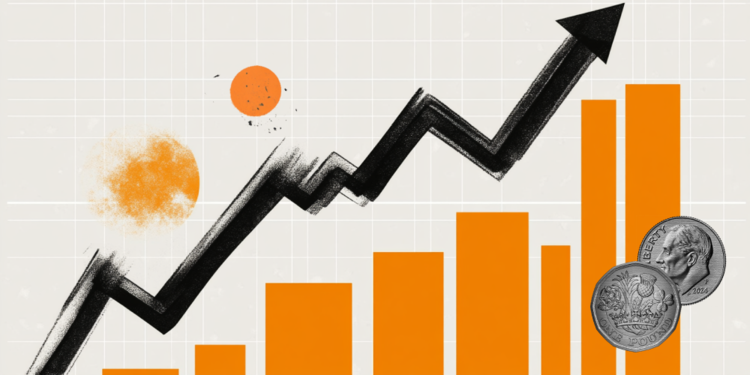Pound Sterling rallies against US Dollar ahead of Fed-BoE monetary policy
- The Pound Sterling shows strength ahead of key central bank decisions this week.
- The BoE is set to lower rates on Thursday, with market participants expecting the central bank to guide an acceleration in policy-easing and lower GDP growth prospects.
- The Fed is almost certain to keep interest rates steady on Wednesday.
The Pound Sterling (GBP) surges to near 1.3390 against the US Dollar (USD) during North American trading hours on Tuesday. The GBP/USD pair strengthens as the US Dollar declines, while investors await the monetary policy decision from the Federal Reserve (Fed), which will be announced on Wednesday. The US Dollar Index (DXY), which tracks the Greenback's value against six major currencies, falls below 99.50.
According to the CME FedWatch tool, the Fed is almost certain to keep borrowing rates steady in the range of 4.25%-4.50%. This would be the third straight policy meeting in which the central bank would leave interest rates unchanged. Traders have remained increasingly confident about the Fed maintaining a status quo on Wednesday, as officials have been arguing in favor of maintaining a “wait and see” approach due to a lack of clarity on the economic outlook under the leadership of US President Trump.
Daily digest market movers: Pound Sterling outperforms across the board
- The Pound Sterling trades firmly against its major peers on Tuesday. The British currency gains ahead of the Bank of England (BoE) interest rate decision, which will be announced on Thursday, and in which the central bank is expected to cut interest rates by 25 basis points (bps) to 4.25%. This would be the fourth interest rate cut by the BoE in its current monetary policy expansion cycle, which started in August.
- Investors will pay close attention to the BoE’s guidance on the monetary policy and the economic outlook in the face of higher tariffs imposed by US President Donald Trump on the so-called “Liberation Day” on April 2. In the March policy meeting, the BoE guided a gradual interest rate cut approach. However, BoE officials had not discounted trade war risk then, which Governor Andrew Bailey stressed to do so in late April.
- Market participants have forecasted that the BoE could roll back its “gradual policy easing” stance and lower growth forecasts. "We anticipate the BoE will downgrade its Gross Domestic Product (GDP) forecasts due to the trade war, and there is a risk the BoE may remove the reference to a ’gradual’ cutting cycle," analysts at Commonwealth Bank of Australia said.
- Meanwhile, traders anticipate that the BoE could deliver two more interest rate cuts this year after Thursday's policy meeting.
- In the US economy, market experts have warned that US President Trump's rollout of new economic policies will be negative for the economy, assuming that higher tariffs could lead to slower economic growth and a resurgence in consumer inflation. “At the heart of the issue is the risk of stagflation, triggered by trade-related cost increases and supply chain disruptions,” according to a Wall Street Journal (WSJ) report by Nick Timiraos.
- On the contrary, US Treasury Secretary Scott Bessent has expressed confidence that the tariff policy will favor economic growth and help reduce the trade deficit. “We think we can get growth back to 3% by this time next year that will help bringing down the federal deficit by maybe 1% per year,” Bessent said in an interview with CNBC Television on Monday.
- US Treasury Secretary Bessent has also assured confidence that Washington can close several trade deals this week. “I am highly confident that 17 trading partners, excluding China, have presented very good trade proposals, and we (White House) are very close to some deals on trade, maybe as early as this week,” Bessent said. On the current status of the US-China trade outlook, Bessent said that we could see “substantial progress on trade with China in the coming weeks”.
Technical Analysis: Pound Sterling stays above all short-to-long-term EMAs

The Pound Sterling climbs to near 1.34000 against the US Dollar on Tuesday. The pair strives to revisit the three-year high of 1.3445. The overall outlook remains bullish as all short-to-long Exponential Moving Averages (EMAs) are sloping higher.
The 14-day Relative Strength Index (RSI) struggles to return above 60.00. A fresh bullish momentum would trigger if the RSI manages to do so.
On the upside, the three-year high of 1.3445 will be a key hurdle for the pair. Looking down, the April 3 high around 1.3200 will act as a major support area.
BoE FAQs
The Bank of England (BoE) decides monetary policy for the United Kingdom. Its primary goal is to achieve ‘price stability’, or a steady inflation rate of 2%. Its tool for achieving this is via the adjustment of base lending rates. The BoE sets the rate at which it lends to commercial banks and banks lend to each other, determining the level of interest rates in the economy overall. This also impacts the value of the Pound Sterling (GBP).
When inflation is above the Bank of England’s target it responds by raising interest rates, making it more expensive for people and businesses to access credit. This is positive for the Pound Sterling because higher interest rates make the UK a more attractive place for global investors to park their money. When inflation falls below target, it is a sign economic growth is slowing, and the BoE will consider lowering interest rates to cheapen credit in the hope businesses will borrow to invest in growth-generating projects – a negative for the Pound Sterling.
In extreme situations, the Bank of England can enact a policy called Quantitative Easing (QE). QE is the process by which the BoE substantially increases the flow of credit in a stuck financial system. QE is a last resort policy when lowering interest rates will not achieve the necessary result. The process of QE involves the BoE printing money to buy assets – usually government or AAA-rated corporate bonds – from banks and other financial institutions. QE usually results in a weaker Pound Sterling.
Quantitative tightening (QT) is the reverse of QE, enacted when the economy is strengthening and inflation starts rising. Whilst in QE the Bank of England (BoE) purchases government and corporate bonds from financial institutions to encourage them to lend; in QT, the BoE stops buying more bonds, and stops reinvesting the principal maturing on the bonds it already holds. It is usually positive for the Pound Sterling.
BRANDED CONTENT
Finding the right broker for your trading strategy is essential, especially when specific features make all the difference. Explore our selection of top brokers, each offering unique advantages to match your needs.
Forex News
Keep up with the financial markets, know what's happening and what is affecting the markets with our latest market updates. Analyze market movers, trends and build your trading strategies accordingly.
